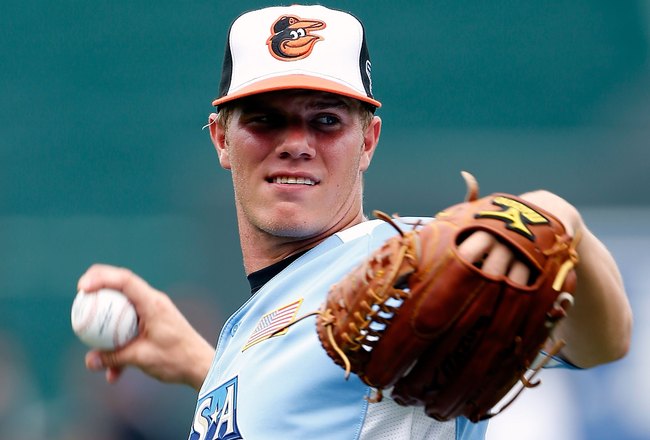 |
|
(Jamie Squire/Getty Images)
|
By Jim Pratt
| @BigLeaguesMthly
With an
18-inning, five-plus hour affair with the Seattle Mariners last night now in
their hip pocket, the Baltimore Orioles continue to defy logic as they find
themselves in a deadlock atop the AL East.
According to
Ken Rosenthal of FoxSports, the Orioles contacted their top
pitching prospect, Dylan Bundy, shortly after their 4-2 win against the
Mariners to inform him of his promotion to the big leagues.
The Orioles
have been reluctant to call-up Bundy, deciding to send him to Instructional
League once the Double-A season ended, but the use of seven relievers last
night has seemingly forced their hand.
Bundy is
expected to be in uniform for tonight’s series finale with the Mariners.
In the
August issue of Big Leagues Monthly | Magazine, columnist Nathaniel Stoltz
discussed his thoughts on Bundy in his Scouting Notebook.
Dylan
Bundy is a fantastic pitching prospect. You don’t need to go see him to know
that. At this point, he’s essentially the consensus top pitching prospect in
baseball, which is no small feat for a guy who hasn’t even escaped A-ball and
is the least progressed of the top four picks of the previous season’s draft.
So yes,
Bundy is terrific. He has four distinct pitches: a fastball with riding life up
and in that’s usually in the 92-94 range, a curveball with sharp, big break in
the mid-70s, a solid changeup at 81-84, and an upper-80s cutter. The fastball
is easily a plus pitch, the curve is unhittable when he sets it up and locates
it, the changeup flashes plus, and the cutter is a nice change of pace when he
locates it.
Many
reports mention the curveball as Bundy’s worst pitch and the cutter as a plus
offering, but in my viewings, the cutter looked a bit on the soft side, and
several ran out over the plate, while the curve was inconsistent but deadly
when he stayed on top of it, forcing some absurd swings by unprepared batters.
He’s supposedly been asked to deemphasize the cutter in favor of working on the
curve this season—at least the latter half of that seems to be paying off.
Given all
the talk about Bundy’s polish for his age, some have suggested he could succeed
in a major league rotation right now. Great as Bundy is, that idea is quite a
bit off the mark. His biggest flaw at this point is a lack of pitch sequencing
ability—compared to some of the polished college arms he was facing, Bundy
didn’t have much of a feel for when to go to his offspeed pitches or what to
use to strike batters out. It’s completely understandable why this is the
case—until he reached High-A, Bundy probably went his whole life getting
batters out using whatever pitch he cared to use. Only now is he starting to
get any sort of pushback and negative feedback from hitters that will really
allow him to assess what is working and what is lagging behind as he advances.
That
makes his issue, which isn’t all that big of a deal for a teenage A-ball
pitcher, not too difficult to fix, and given that Bundy receives high marks for
his acumen and work ethic, there’s no reason he won’t get a better sense of
when and where to throw what as he continues to progress. Still, Julio Teheran
and Jacob Turner have been waylaid by similar issues in Triple-A and the
majors, so it’s not out of the question that Bundy will experience some bumps
in the road when he gets to those levels.
Overall,
Bundy looks on a path to have a lot of major league success. He has a diverse
and effective arsenal with good mechanics and control, with a lot of
development time in front of him to tighten things up. He might not quite make
it into the Justin Verlander/Clayton Kershaw class of ridiculous aces, but a
career along the lines of Matt Cain’s seems feasible. Barring a total meltdown,
he’s a #3 starter at the worst.
You can
follow Nathaniel Stoltz on Twitter @stoltz_baseball. Along with his regular contributions to
Big Leagues Monthly | Magazine, he also writes for Beyond The Boxscore
and hosts the20-80
Report podcast.

No comments:
Post a Comment